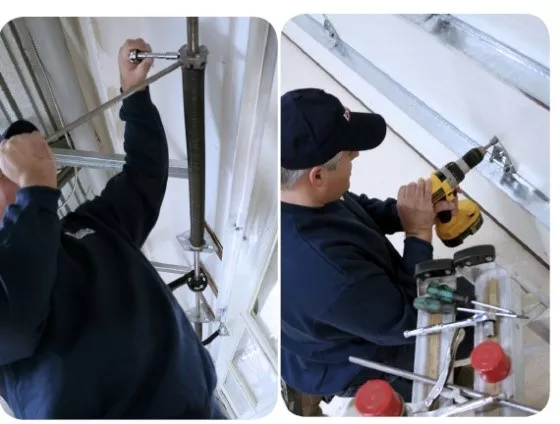
Spring break might sound like a lot of fun, but that isn’t always the case. At least it’s not when you’re talking about hearing a loud noise that comes from your garage when you least expect it. Once you get over the initial shock, you head to the garage to see what just happened. You may not notice anything strange at first glance. But when you go to use your garage door, you may notice it isn’t working the way it should be. You may also hear a strange noise when you try to open it up. So you take a look up and realize that lifting spring has split into two different pieces!
So, what could cause this to happen out of the blue? You might wonder if you missed a sign that something was wrong with your garage door. The reality is that there are several causes. We’ll explain what they are and what may have happened with your own lifting spring.
One of the most important parts of your garage door is the spring system
First things first, you need to have an understanding of what the spring system is and what it does. Assuming you are referring to a residential door, there are two main types of spring systems:
-
EXTENSION SPRING
The other type of spring system can be found on each side of your door just above the horizontal tracks. The name of the system says it all as the spring is coiled but extends in order to lower or lift the door. If you have extension springs, a professional garage door expert will install them with safety cables. This prevents the cable from falling and smashing into your car or other belongings if the spring breaks.
-
TORSION SPRING
If you have this type of system, it will be in a steel tube which is located above the head of the door. It will be attached to the wall so that the weight of the door is transferred to the anchor plate found at the center of the door. If you do not have sufficient room over the door, the plate may also be on the end of your horizontal tracks. If your spring system is this type, it is called a low headroom system or double horizontal track system.
Something else you should know is that whichever spring system you have acts as a counterweight for the door and its entire weight. If you have, as an example, a front door of 9 x 7 feet with a row of windows, you can expect its deadweight, or total weight, to be around 135 pounds or 61 kilos. The reason you can lift the door with a single hand is because it has been counterbalanced by the spring system. When your garage door is balanced appropriately, it will only weight around 8 to 10 pounds or 3.5 to 4 kilos, including your electric garage door opener! The door opener is only made to take the place of your manual effort, despite being capable of lifting around 200 pounds or 90 kilos. What you need to remember is that if your door opener can lift this much weight, it can also press down at the same amount of weight. This can be disastrous, which is why you should never be in the path of your garage door as it descends.
Reasons your lifting spring could break
There are many different causes of a spring break, but we will go over the most common of them all:
-
Environmental problems
If your garage is not heated or insulated, it’s not surprising that it can be humid and cold. Even those who have some amount of insulation and heating will find that the springs can stay damp and cold due to being close to the outside walls. While galvanization helps protect against rust, some rust will still eat at the metal. If you are in temperatures below -15F or -26C, the metal wire that is coiled up can break after becoming too dry.
-
A bit too much wear and tear
A spring has a lifespan of between 5 and 7 years, regardless of whether it is extension or torsion. In many cases, a garage door manufacturer will provide a 10,000‑cycle spring systems. One cycle is defined as being one opening and closing of your garage door. That means if you use your door about two to four times a day, in one year you will go through about 1500 cycles. For people who use the door 5 or more times a day, you may want to be on the lookout for the 20 to 25,000‑cycle springs that some manufacturers offer.
-
Possible manufacturing defects
There is always a chance that your springs will have some sort of defect, even if it’s not as common as wear. With an extension spring, the most common issue would be the ring on the end of the spring breaking. If you have a torsion spring, the most common issue is low‑quality galvanizing which allows rust buildup and causes problems.
-
Providing little to no maintenance
No matter how high-quality your door and lifting system is, it still needs maintenance on occasion. Garage recommends that you lubricate all metal parts that contact other metal parts at least twice a year. One time should be done with the temperatures are below freezing and the other time should be done when the temperatures are a bit warmer.
-
Incorrect calibration of springs
This is even more rare, but in some cases, you may find that the wrong spring system is installed. This doesn’t mean that the door won’t open and close because it usually will. However, it also means extra stress is being placed on the opener, door, and spring. A spring is considered to be properly calibrated within 5% variation so that means a spring that is meant to hold a door of 100 pounds or 45 kilos is not appropriate for use with a 150 foot or 68 kilo door.
If you want to ensure a long life for your spring system, consider the advice below.
You will want to lubricate your springs at least once a year, although twice is even better. This can be done by using petroleum‑based oil, just like the motor oil you use for your vehicle. You’ll want to apply to around your coils using a soft cloth. After you’re done, take a moment to sop up any extra oil and you are good to go. This maintenance task has a secondary benefit, as well. It can stop the clinking noise you hear from springs whenever they stretch out and then release. Whatever you do, avoid using WD‑40 as your lubricant. It is a degreaser and does not lubricate the metal parts. You can contact a Garage dealer to get the lubricants you’ll need to service your garage door.
What can I do if I prefer someone else handle this for me?
You don’t have to do the work yourself. In fact, we offer a “Garage Door Tune‑up” program that is similar to the one you may find at your car dealer when you stop in for maintenance.
You can contact us. We have great knowledge about every aspect of garage doors. We can give you advice and explain what your best options are based on your needs and budget. We’re also happy to offer you a quotation by email.
If you prefer, you can also visit and meet us at our showroom. To get an idea of the style of garage door that best fits your home, you can use our Design Centre. We also have an image gallery if you need a little extra inspiration.


Add new comment